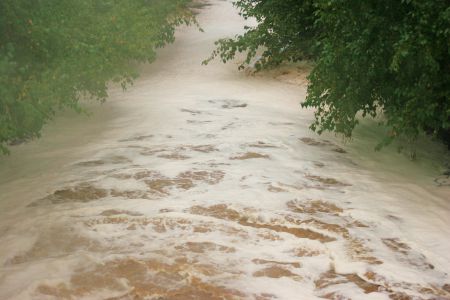PICTOU, NS – The Abercrombie Point Pulp and Paper Mill in Pictou, Nova Scotia, has woven itself a tangled web indeed. There appears to be such a wide-ranging and diverse flow of information emanating from the mill that the Pictou County Watershed Coalition (PCWC) cannot even get a straight answer as to what happens to the effluent run-off once it leaves the tail end of the mill, and settles in Boat Harbour. Eyewitness reports note that sludge from Boat Harbour is now being loaded onto conveyor belts, loaded onto trucks and driven off into the night. Where these trucks go, whether their cargo is being treated as toxic waste and where their cargo finally winds up, are questions with more than one answer at the moment.
On the one hand, Darlene Fenton, executive director of Environmental Monitoring & Compliance, on behalf of Environment Minister Sterling Beliveau, noted in a 2010 letter to the PCWC that:
“The Northern Pulp Mill generates its own power on site by the use of a recovery boiler and a power boiler, sometimes referred to as a hog fuel boiler ... The power boiler utilizes wood products such as wood chips and bark as well as biomass produced from the settling and drying of wood fibre at the Boat Harbour Facility.”
If material currently being conveyed out of Boat Harbour settling ponds is being used to fuel the power boiler, it is an even more liberal usage of the term biomass than perhaps the public ever conceived it to be. Biomass burning is considered “renewable” energy in Nova Scotia, but surely the leniency in calling settled Boat Harbour waste “biomass” takes the proverbial cake.
Added to this is the fact that PCWC has obtained a copy of the Abercrombie Mill's Air Management Plan that explains that the mill's power boiler “exceeds permit levels on all tests.” The Air Management Plan points to the fact that the boiler's scrubber has been out of commission since 2006. If Boat Harbour waste is indeed being used to fuel the power boiler, this would mean that emissions escaping from the power boiler are essentially unfiltered. This might go some ways to explain why Pictou County has the highest rates of cancer in the country.
Estimates for a new boiler scrubber run in the range of $2.4 million, and no public mention has been made of purchasing a new one, which is sad, considering that the mill was, in 2011, the proud new recipient of $28 million through the federal government’s Canadian Pulp and Paper Green Transformation Program to go toward improving environmental performance.
Indeed, the legality of burning Boat Harbour dredge is seriously in doubt. Don Breen, vice-president of Strategic Planning and Government Affairs, will only publicly commit to mentioning that the mill burns Boat Harbour dredge on “test burns,” for which a permit is required. If the mill has been burning since 1967, as is mentioned in the Darlene Fenton letter, have they been continuously renewing test permits? Or what?
On the other hand, Pat Ryan, worker for Clarrie MacKinnon, MLA for Pictou East, assures the PCWC that the dredged waste is only being burned under test permits (again, whatever that might mean), and that all “dredged material is being buried”.
If this is the case, where is it being buried, and under what conditions? What precautions are being taken to ensure that this toxic material is not polluting the water table of the undisclosed burial site? One member of the PCWC raised the ominous possibility that Boat Harbour dredge might be being applied to clear-cut patches, and urged Nova Scotians to be alert for this.
“In a larger context, it continues to be a series of confusing and contradictory stories from the mill,” says Ron Kelly, spokesperson for the PCWC. “It leads us to wonder if the Ministry of Environment is actually running this, or aware.
“Our bottom line is health concerns. It is questionable what this system is putting out, and what safeguards there are. There are continuous reassurances from the mill, but these are seriously in doubt at the moment.”



